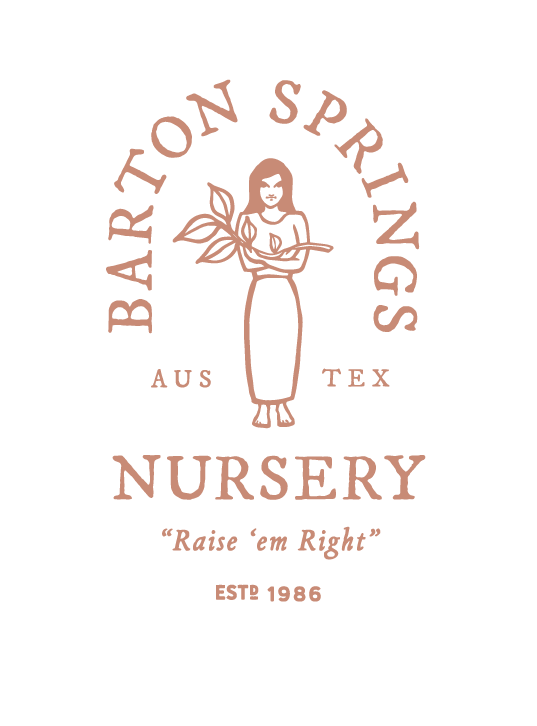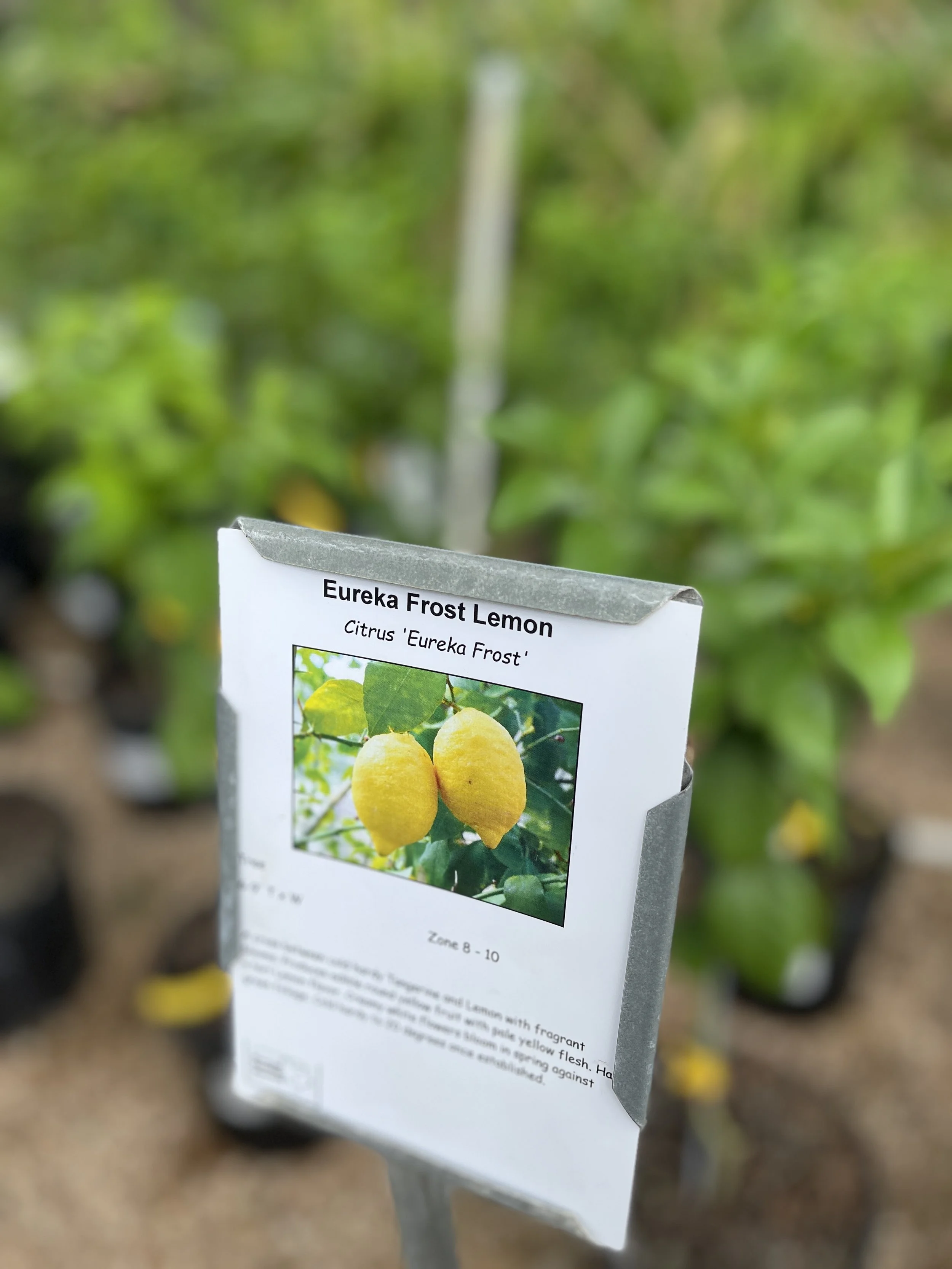Citrus in Austin
We’ve got citrus in stock ready to plant!
Mature citrus trees in the ground can reach up to 10-15 feet tall and wide. Mature citrus in a container can reach up to 6-8 feet tall and wide, depending on container size. Width is determined by trunk structure; multi-trunked are typically wider than single-trunked. All citrus prefer 6-8 hours full sun per day and need deep soil with good internal and surface drainage. Fragrant blooms can appear in spring or fall followed by fruit. Fall fruit set may be damaged if exposed to freezing temperatures. Fruit yield increases with maturity. In areas prone to freezes, a spot on the south or southeast side of the house will offer protection from northwestern cold front. ALL ARE SELF-FERTILE. ALL ARE GRAFTED TO HARDY CITRUS ROOT STOCK.
Calamondin: Hybrid of kumquat and citrus. Small fruit resembling a mini tangerine, with thin peel and few seeds. Very juicy with slightly sweet but acidic flavor. Common citrus in tropical zones. Can be eaten raw, used to flavor drinks, jellies and variety of foods.
Calamondin- Variegated: Variegated variety of Calamondin. Fruit the same as standard except for variegated peel.
Citron – Buddha’s Hand: AKA the Fingered citron; fragrant, strongly aromatic variety historically used as an offering in Buddhist temples. Used as an insect repellent and an air freshener. Fruit is split into 5 or more finger-like segments; Fruit often has no pulp but consists entirely of edible fleshy peel that can be steamed or candied.
Grapefruit – Rio Red: Red, fleshy sweet fruits are almost seedless with a red-tinged skin in fall. Sweeter than most grapefruit; great for juicing.
Lemon – Bearrs: Vigorous and thorny tree. Out produces Eureka. Abundance of very juicy acidic fruit July through December. Outstanding flavor.
Lemon – Eureka: Fruits have a smooth medium thin rind, high juice content, high acid level, few seeds and good flavor. The trees are less thorny than many other lemon varieties, which makes picking easier.
Lemon – Eureka Variegated: Fruits have pink flesh and juice. The juice is used in mixed drinks. The leaves and peel of the fruit is bi-colored. Makes an attractive ornamental plant.
Lemon – Improved Meyer: Small to medium size orange yellow skinned citrus with a lemon like flesh that is juicy, but considerably less acidic and much sweeter than common lemons. The flesh and juice are "pinkish". Intensity of the red color depends on climate and soil. Fruits are eaten raw, used in making juices, desserts, and for flavoring. Has become very popular in recent years for its unique lemon-like flavor, without the acidic sourness.
Lemon – Lisbon: More productive, vigorous and thorny than Eureka. Fruit very similar to Eureka, except Lisbon has less pronounced nipple; smooth medium thin rind, high juice content, high acid level, few seeds and good flavor.
Lime – Mexican: Most acidic of the common citrus fruits used in cooking. This is the round lime grown especially in Mexico, Florida and the West Indies. Color varies from dark green when immature to a yellowish green when ripe. For food and drinks it is best medium ripe, when still green.
Lime – Mexican Thornless: Thornless variety of Mexican lime.
Mandarin – Atlas Honey: Also called the Murcott, it is from an old Tangor variety, a hybrid between a Mediterranean and a King Mandarin. Fruit has a deep orange exterior, is thin skinned and has a glossy texture. Slightly flat in shape with no neck. Very juicy, peels and segments easily and has many seeds. Fully ripe late November, so start tasting early November.
Mandarin – Kishu Seedless: Small sized tree makes a good container specimen. Small fruit, <2 in. diameter, but sets reliable crops. Easy to peel, thin orange rind. Flesh is bright orange, seedless, mild-flavored, sweet, and juicy. Early in maturity, and the fruit holds well on the tree. Mandarin – Miho Satsuma: Medium size tree producing medium size, round fruit, ripening in October through November, that is easy to peel and mostly seedless. Good sugar content.
Mandarin – Okitsu Satsuma: Medium size tree producing early ripening, late September to October, medium size, round fruit. Good sugar content.
Mandarin – Seto Satsuma: Medium size tree. Seto peel is clearly smoother and thinner than other Satsumas. The fruit is noticeably flat, not spherical, and packs easily. Ripening October through November.
Orange – Cara Cara Navel: Considered a light blood orange, Cara Cara has a pink flesh. It is due to lycopene as opposed to the anthocyanins of true blood oranges. Tender pulp with rich flavor. As with grapefruit the color can gradually become less intense as the season progresses. Medium size fruit are very sweet with low acidity.
Orange – Hamlin Sweet: An early variety, the first fruit reach maturity in October and are seedless. Hamlin is juicy and very productive. It is one of the most important varieties for the Florida orange juice industry.
Orange – Moro Blood Orange: Perhaps the best-known blood orange throughout the world. Rind is medium-thick, moderately adherent, and somewhat pebbled. Orange-colored skin at maturity with a light pink blush or red streaks at advanced maturity. Darkest flesh of the blood oranges due to high amount of anthocyanin pigment (an exciting deep purple that is about to turn black). The fruit is juicy and the flavor is pleasant. Very early in maturity (earliest of the commercial blood oranges), but holds well on the tree and stores and ships well.
Orange – Republic of Texas: Medium to large size tree with deep green foliage and many thorns. A cold hardy sweet orange dating back to the 1800’s. Fruit is medium sized. Highly flavorful, sweet, juicy and slightly seedy. Ripens November through December.
Orange – Valencia: Most widely planted orange variety in the world. It originated in either Spain or Portugal, but no one knows which. Introduced to Florida in 1870. 'Valencia' fruit are medium large, commercially seedless, with a moderately thick peel. It is usually slightly oblong in shape. Peel color, juice color and eating or juice quality are excellent, setting the standards to which other round oranges are compared. It matures in early February and holds well on-tree into the summer. Fruit will regreen at the time of the spring growth flush.
Tangerine - Changsha: Produces crops of small, sweet, seedy tangerines. Typically fruits heavily in alternate years. One of the more cold hardy types of citrus. Established plants cold hardy to 15 degrees; has survived temps of 4 degrees. Upright form.


